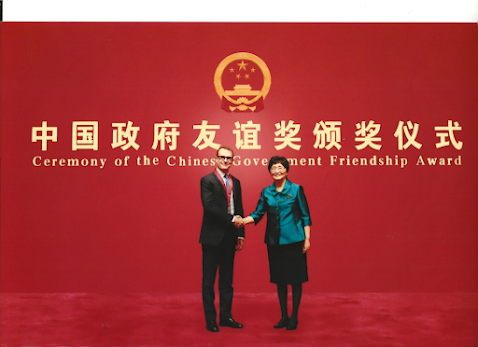Zhou Jinfeng's 4 Suggestions on Wildlife Renaissance: Transformative Initiatives in Hangzhou Bay Wetland Preservation
On April 20, 2024, Dr. Zhou Jinfeng, Secretary-General of the China Biodiversity Conservation and Green Development Foundation (CBCGDF) and a member of the IUCN Connectivity Conservation Specialist Group (CCSG), conducted a field visit to the Hangzhou Bay National Wetland Park located in Ningbo, Zhejiang Province. This park is an integrated area for wetland restoration, research, environmental education, and tourism, situated at the northern boundary of China's coastal wetlands and serving as a critical stopover along the East Asia-Australasia flyway for migratory birds, making its ecological positioning highly significant.
Based on this research visit, Dr. Zhou Jinfeng proposed eight recommendations, of which four are highlighted below:
Firstly, Dr. Zhou suggested initiating long-term data collection and inclusion in the Hangzhou Bay Wetland Park through the Global Biodiversity Information Facility (GBIF), encouraging citizen scientists to actively engage in daily biodiversity observation and recording. Citizen scientists play a vital role in biodiversity conservation and are significant contributors to biodiversity informatics. The CBCGDF leverages GBIF data to facilitate public participation in biodiversity conservation efforts.
The release of wetland species data contributes to wetland scientific research and conservation efforts. Recording and sharing ecological information on species inhabiting wetlands deepen our understanding of local wetland ecosystems, providing a scientific basis for future protection and management.
The Global Biodiversity Information Facility (GBIF) is an international network and data infrastructure funded by governments worldwide, aimed at making data on all types of life on Earth accessible to anyone, anywhere. The China Biodiversity Conservation and Green Development Foundation is the second official GBIF data publisher in China. Since joining GBIF in 2018, the CBCGDF's GBIF team has been serving scientific researchers, citizen scientists, and conservationists, contributing to biodiversity informatics data.
Secondly, Dr. Zhou recommended enhancing wetland park management to promote "rewilding" and minimize human disturbance. As a nature-based solution, allowing wildflowers and grasses to grow naturally not only supports biodiversity conservation but is also an essential part of ecological civilization. Creating spaces friendly to wildflowers and grasses provides them with the freedom to grow naturally. Building an Earth community requires humans to respect, adapt to, and protect nature. By avoiding disturbance and interference, we can promote harmonious coexistence between humans and nature.
Thirdly, Dr. Zhou proposed establishing a bird museum within the wetland park, a concept which can be supported by the CBCGDF's Biodiversity Museum. For example, displaying bird paintings from this area dating back a century could be part of the exhibition; helping renovate entire buildings to be more "bird-friendly" and "biodiversity-friendly," encouraging the use of "swift bricks" and "bird bricks" in architectural designs that allow wildlife to partially use and share human-built structures.
The construction industry, which has a profound impact on ecosystems and the natural environment, should consider the importance of biodiversity conservation while addressing climate change. Chinese leaders emphasized at the fifteenth Conference of the Parties to the Convention on Biological Diversity (CBD) the need to promote green development through biodiversity conservation.
By designing ecologically friendly buildings, creating more habitats, promoting biodiversity, and maintaining ecological balance, wetland parks' ecological value can be enhanced, attracting wildlife and providing citizens with richer viewing experiences. Biodiversity-friendly architecture helps protect genetic libraries of flora and fauna, enhances adaptability to environmental changes, and promotes the sustainable development of parks. Additionally, by introducing interesting designs, public awareness of ecosystems can be raised, stimulating active participation in ecological conservation and promoting urban sustainability.
Lastly, Dr. Zhou suggested considering rewilding some Milu deers into natural habitats. In coastal areas without visitors, creating natural the deers habitats allows them to play a significant role in the ecosystem.
The Milu deer is a deer species native to Chinese wetlands, rich in historical and cultural significance, with royal origins and noble lineage. Its gentle beauty and independent posture, dwelling by the water, embody a living natural heritage. Throughout history, the rise and fall of Milu have been closely related to the nation's honor and disgrace. Advancing ecological civilization, constructing natural ecological corridors for wild Milu, promoting harmonious coexistence between humans and Milu, and reintroducing large groups of Milu to the wild land of China can restore spectacular scenes of the endangered species' to the earth.
(Written based on voice transcription, unverified by the author, for reference; stay tuned for subsequent reports on the other four recommendations.)
Article By Samantha
Translated by Linda
Editor: Samantha
Contact: v10@cbcgdf.org; +8617319454776
Contribution
Do you know? We rely on crowd-funding and donations. You have the opportunity to help an international movement to advance biodiversity conservation. Donate TODAY to power up the movement to make it a better world for all life.
Donation(501C3)Paypal: intl@wbag.org
https://www.paypal.com/donate/?hosted_button_id=2EYYJJZ8CGPL











Comments
Post a Comment